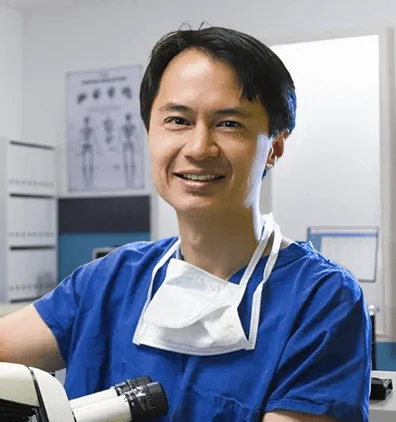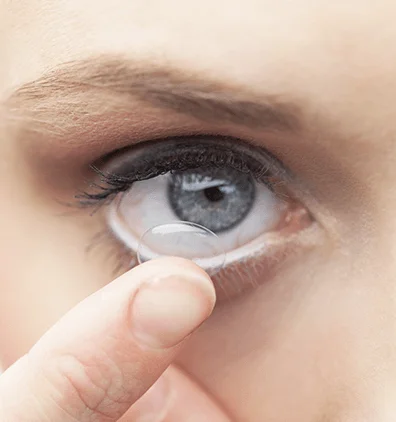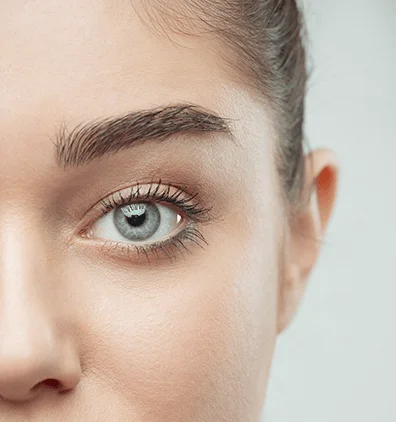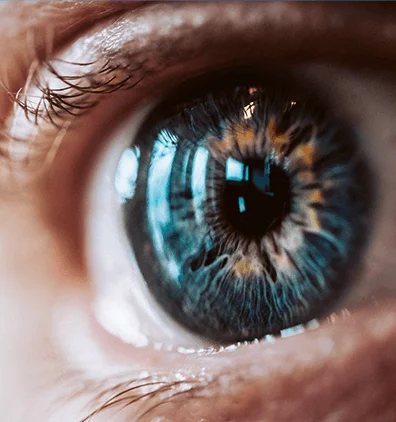Amblyopia Treatment
Amblyopia (“Lazy” Eye or Eyes)

(This article is adapted from a series of lectures that Dr. Chynn has given internationally, teaching eye surgeons
around the world why he can treat amblyopia in adults that most eye doctors have “given up” on helping”)

Our Videos
Frequently Asked Questions:
“There are two causes of amblyopia: misaligned eyes (strabismus) or eyes that have very different prescriptions (refractive errors).
“To understand how this causes amblyopia I’m going to have to teach you something about neuroanatomy & physiology, like I learned at Columbia & Harvard, but in a simplified fashion, so it’s easy to understand. People with amblyopia often say I’m better at this than all the eye doctors they’ve ever seen, maybe because I received a minor in Education while at Dartmouth, & also taught tenth-grade biology in inner-city Newark before going to medical school. If I could succeed in that very difficult challenge, I can certainly successfully teach any motivated adult amblyope about their condition (& fix it as well—but before I’m willing to discuss any amblyope’s treatment, I first require them to understand the science behind it, or it won’t make any sense)
“There exists what’s called a “critical period of visual development” in humans (actually in all mammals). This period starts at birth & extends until the age of about 11. We used to think it ended at 6 years old, but now understand that the human brain is more “plastic” or malleable than doctors thought 30 years ago. This is why strike victims can regain function. The part of the brain that suffered a lack of normal blood flow during the stroke is dead—100%, irrevocably dead. Any recovery comes from an adjacent part of living brain subsuming (taking over) that function. This explains why that’s usually imperfect (like halting speech or unsteady walking)—because the “substitute” area of brain is doing its best, but wasn’t designed for this function. It’s like a substitute English teacher taking over when the math teacher is out—better than nothing, but certainly not ideal.
“During this critical period, if you took a perfectly healthy infant or child, and for some bizarre reason patched one of the perfectly normal eyes for a period of time (say from 1-2 years), and didn’t do anything to physically harmed that eye, then removed the patch, that eye would be legally blind forever, without any hope of improvement. This is because the visual cortex, or part of the brain tasked with receiving & processing visual information from the eyes, will have been deprived of this signal for that year of patching. So the brain will “ignore” any later signal from that eye at a later date—even if that signal is essentially normal from a “normal” eye
“As an aside, there’s also a critical period of linguistic development in all animals. So the Tarzan story is not possible scientifically, because if an infant was raised by apes & then adopted by humans as a child, that boy would never be able to learn English or any other language, because that period of visual development has passed. We scientists have even done studies, where we separate young birds from their parents & flock, then reunite them, but these birds never learn to sing normally—proving there’s a critical period of visual & linguistic development in all animals
“So now you understand how & why amblyopia develops. The medical term is “visual deprivation”. If your eye (or less commonly, eyes) are deprived of the proper visual input, or if it sends a defective (blurry) signal to your brain (specifically the visual cortex), the eye-brain connection will not develop normally, even with a physically normal eyeball. This leads to the medical definition of amblyopia: the inability to see 20/20 from a physically normal eyeball, even with any glasses or contacts prescription
“Now let’s discuss the two causes of amblyopia. Strabismus means that the eyes are mis-aligned. It’s more common to be misaligned inwards (“cross-eyed”), although one eye can be out instead (“wall-eyed”). Often the child develops the (unconscious) habit of partially closing the misaligned eye to block out the image from that eye to prevent diplopia, or double image. This is why lay people & optometrists sometimes refer to amblyopia due to strabismus as “squint”
“In amblyopia due to strabismus, the misaligned eye becomes “lazy” because the brain ignores this misaligned image to prevent double vision.
“Amblyopia can also be caused when there is a large difference between the eyes in refractive error, or prescription. Even most eye surgeons starting my Refractive Fellowship (which is a 1-2 year program where eye surgeons from the US or abroad can complete a rigorous, formally sanctioned SF Match Fellowship in Refractive Surgery under my tutelage, which is quite prestigious, as there are only about 20 in the entire US) much higher in one eye than the other) often erroneously think that the eye with the “worse prescription” is the one that becomes lazy, so I really must explain this point more thoroughly
“Infants are not concerned with distance vision—it’s not like they’re driving cars. All they do 24/7 is grab objects & hold them close, then try to stick them in their mouths, because this is how all young mammals explore the world. In addition, their arms are so short that the objects they’re looking at are only inches away from their faces
“Nearsightedness or myopia means the eye has a refractive error where near images are in focus (but distance images are blurry. Farsightedness or hyperopia means distance images are in focus, but objects up close are out of focus. This leads to the obvious conclusion that nearsightedness is useful for infants to see up close, whereas farsightedness is not
“Therefore, if the two eyes have markedly different prescriptions, the more nearsighted eye will produce a clearer image to the infant holding objects up to his face, and the less nearsighted (or more farsighted) eye will produce a blurrier image of close-up objects
“Thus, based on what I’ve already explained about visual development in the visual cortex, the infant brain will ignore the blurrier image, which is always going to be from the eye that’s less nearsighted or more farsighted
“Let’s give some examples to make this more clear. For example, if one eye is nearsighted, while the other is farsighted, the farsighted eye becomes lazy. If one eye is -6 and the other eye is -2, the -2 eye with the smaller Rx becomes lazy (because it’s less nearsighted so produces a worse image at near). If one eye is +1 and the other +5, the +5 eye becomes lazy (because it’s more farsighted, so produced a worse near image). If one eye is 0 or has no Rx, but the other eye is -4, the 0 eye will actually become lazy (because the -4 eye sees better up close). If one eye is 0 but the other is +3, the +3 eye becomes lazy (again because the more the Rx goes in the + direction, the worse the near image is focused)
“So congratulations—now you the lay person with amblyopia has a better understanding of the pathophysiology of your disease than most eye doctors, whether MDs or ODs;)
“If amblyopia is not treated, the brain will learn to disregard the vision from the eye that produces the worse signal.
“The treatment of refractive amblyopia (the type due to a Rx difference between eyes) is the same as for strabismic amblyopia—you must patch the eye with the good image in childhood, to force the brain to attend or pay attention to the bad signal from the misaligned eye or more farsighted eye,” explains Dr. Chynn
Usually children refuse to wear the patch sufficiently, which is most of the time, because they don’t like how it looks, and/or because they see worse (after all, you’re patching the better seeing eye). So how much patching works to prevent amblyopia depends on how early it’s started, & how compliant the parents can force the child to be (which is easier with higher parental income & education, as they understand the necessity & have the time to force compliance)
“If the child refuses patching, in cases of refractive amblyopia, you can “penalize” the “good” (more nearsighted) eye with atropine drops, which dilate the pupil & prevent that eye from focusing up close—thereby turning it into the worse eye for near (& forcing the brain to attend or pay attention to the fellow eye). This is a technique that’s vastly underutilized in the US—I’m not sure why, it’s used much more often in Asia, & works great. Again, I can certainly examine your child & atropinize your child if he or she won’t wear a patch to preserve his or her vision” offers Dr. Chynn
“If the eyes are excessively crossed, strabismus surgery by a pediatric ophthalmologist will probably be necessary to physically align the eyes. This is accomplished by cutting and moving or shortening one or more of the six eye muscles controlling the movement of each eye, to relatively weaken or strengthen those muscles. If the ocular deviation is very large, both eyes’ muscles will be adjusted. This surgery is usually performed in childhood.
“Vision therapy” for amblyopia consisting of “eye exercises” is more often than not a waste of time & money,” cautions Dr. Chynn. “Some unethical ODs prey upon parents to spend thousands of dollars on bizarre ‘exercises’ that have no chance of working. In some cases these optometrists might be misguided and under-educated, instead of dishonest. But ‘vision therapy/eye exercises’ are only appropriate for perhaps one in ten children they’re prescribed for. My advice is never start these treatments unless you first see a pediatric ophthalmologist (who has completed an official SF Match Fellowship in Pediatric Ophthalmology) or licensed orthoptist who will then determine if this treatment will help your child. Again, the indications or situations where it may are much more rare than how often they’re sold (e.g. it’s appropriate to do “pencil pushups” but only in those rare children with a “low AC/A ratio”)
“A proven but underutilized treatment for children with refractive amblyopia is HD LASEK. By eliminating the refractive error (prescription) with the excimer laser in the eye that’s becoming lazy (due to patching noncompliance) I can halt the progression of amblyopia,” states Dr. Chynn. “As I’ve hopefully taught you, it’s the more farsighted or less nearsighted eye that becomes lazy. Therefore, by eliminating this discrepancy in prescriptions between the child’s two eyes, I make him or her into a normal child, with normal eyes, with no tendency to become lazy
“Let’s use some examples again for illustration purposes. Let’s say your child has a Rx in one eye of -1, and in the other +1. From what I’ve taught you, you now know that the more farsighted eye will become lazy over time. But if I use the excimer laser to perform a HD LASEK, I can change the Rx of the +1 eye to become -1. This wil take approximately 15 seconds of laser treatment time. Afterwards, it takes only a few days for that eye to heal. Children’s eyes heal more quickly than adult eyes. Within a week, the lasered eye will be fully healed, with its new -1 Rx. Now there’s absolutely no reason for that eye to get lazy, because it’s Rx is identical to the other eye, & the brain receives equally sharp images from both eyes. So I’ve successfully treated—and in some sense cured—the amblyopia in that eye, haven’t I?
“In cases where both eyes have an extreme and unequal Rx, I can HD LASEK both eyes. For example, let’s say one eye is +3, and the other +6. Without treatment, the +6 eye will lose vision every year. But I don’t have to just make the +6 eye a +3 eye. I can laser both eyes, and get rid of the entire Rx in both eyes! So afterwards, your child won’t just not have unequal eyes—he or she will have perfect eyes, the eyes that God meant your son or daughter to have!
“So if you’re a parent and you’ve got a child with refractive amblyopia, & have a desire that he will become a good athlete, or she will not be disadvantaged by unsightly glasses (or the reverse, not to be sexist), don’t dispair! I can perform HD LASEK on your child, & give them a normal future, without having to wear funny-looking glasses that comprise their athletic ability, diminish their confidence, and in many cases don’t provide optimum vision in any case (see a further explanation of why below).
“Now that I’ve forced you to spend the time listening to me explain all the things about amblyopia properly, that your previous doctors never bothered to do, either due to lack of understanding or time,” jokes Dr. Chynn, “I’m now willing to explain how I can treat amblyopia in adults!”
“Because the most adults with amblyopia had tried at least one of the above treatments in childhood, or have some vision in their lazy eye, I can improve the vision in the vast majority of adults with amblyopia,” states Dr. Chynn.
“As I mentioned above, the brain is more ‘plastic’ or adaptable than we physicians & surgeons previously thought. This is how Christopher Reeves, who played Superman in the movies, was able to regain some function in his legs after becoming totally paralyzed in a horseback riding accident. Doctors hooked his legs up to neural stimulators, similar to TENS or the (fake) muscle-building electrodes you see advertised on late-night TV,” explains Dr. Chynn. After years of this stimulation, the brain was able to make new connections to nerves so he was able to wiggle his toes
“Let’s say you have a small ocular deviation or turn, and resultant predominant strabismic amblyopia. It’s cosmetically acceptable so people don’t stare at you, but it’s noticeable to you (often women are more self-conscious of this), or becomes obvious to others when you’re tired and/or drunk (men report this situation more commonly).
“I can use my excimer laser to put a very mild prescription on that eyeball to make the eye stay straighter. To understand how this works, you’ll need to bear with me while I teach you about the ‘triple reflex’. Again, most starting Fellows in my Refractive Surgery program aren’t clear about this, so it’s understandable that no lay person (& most eye doctors, whether ODs or MDS) would be
“The ‘triple reflex’ is what allows all people to look at objects at near. Three things happen in your eyes when you look at something up close: they converge (move so they’re turned-in or cross-eyed), the pupils constrict, & a mechanism inside the eye makes it nearsighted so you things are near are in focus (this is called ‘accomodation’). All three things are linked because they’re controlled by a single ‘nucleus’ in your brain. You can’t do one without doing the other two to some extent
“I uniquely (among eye surgeons in the US) routinely employ the Triple Reflex to straighten out patients’ eyes. For example, if a patient has a mild esotrophia (cross-eyed), I put use my excimer laser you put a mild nearsighted prescription on the cornea of the turned-in eye. This decreases the need to accommodate, which in turn decreases the signal to converge—thereby helping to straighten the eye
“Similarly, if a patient has a mild exophoria (‘wall-eyed’) then I put laser a mild hyperopic prescription onto that eye’s cornea to make it mildly hyperopic or farsighted. This stimulates accomodation, which because of the Triple Reflex simultaneously triggers convergence, thereby bringing the eye in & helping keep it straight!
“I’d like to stress that excellent results can be obtained even in adults with eyes that are grossly (obviously and seriously misaligned),” says Dr.Chynn. “I’ve helped hundreds of adults who’s misaligned eyes were never fixed, usually because they didn’t have access to modern “Ivy-League quality” eye surgery as a child. Usually they were born decades ago, or in rural areas, or to non-wealthy parents, or in other, less developed countries. I’ve struck up conversations with adults on the subway, explained all of this, then referred them to a pediatric ophthalmologist who takes their medical insurance, so the straightening surgery is free! This can be truly life-changing.
“Most pediatric ophthalmologists I work with agree the proper sequence in these cases is usually for me to first do my laser, and then for them to do their muscle surgery. But in a minority of cases, the reverse sequence makes more sense.“
“If you’re an adult patient with refractive strabismus, the solution is even more straightforward. Using my unique, trademarked HD LASEK technique, I’ll eliminate your prescription in the lazy eye, after which it will actually often have a lower prescription than the other eye! After this, the brain has no choice but to pay attention to the signal from that eye!
“I’ve done this now for hundreds of patients, and they’ve been pleased with their results. Often they see better after HD LASEK treatment for adult amblyopia than the best vision they were ever able to achieve with glasses or contacts! There are many reasons why I can often make patients with refractive amblyopia see much better than they do now—and often achieve better vision than has been possible in glasses or contacts:
1. Often, the amblyopic patient has been prescribed “balanced” glasses that do not fully correct the prescription in the lazy eye, so do not provide the best vision that is possible. Why is this? Because most patients can tolerate a maximum of 2 diopters of prescription difference between the eyes. More than that causes an inability of the brain to fuse or combine the images from the two eyes due to isoconia (image size disparity). So your optometrist probably intentionally undercorrected your lazy eye—without telling you. But the excimer laser can eliminate the Rx in each eye, thereby also eliminating any isoconia. So by fully correcting the Rx in the lazy eye, rather than only partially correcting it, the excimer laser can often make lazy eyes see better than they can see in glasses.
2. Contacts don’t come in extreme prescriptions, because not enough people need such extreme corrections, so it’s not worth it for manufacturers to make such lenses. “Most contacts only go up to +3 or -9 or 2.75 diopters of astigmatism (which is another cause of refractive amblyopia), whereas I’ve seen & treated many lazy eyes between -10 and -20, or between +4 and +8, or over 3 diopters of astigmatism with LASEK,” says Dr. Chynn.
3. Many patients with a lazy eye don’t even bother to wear their prescription in that eye, since the resultant vision is still worse than in the fellow eye.
4. HD LASEK can treat many prescriptions 25x more accurately than is even possible in glasses & contacts. The increment of precision of the excimer laser is +/-0.01 diopters, whereas its +/-0.25 diopters with glasses & contacts.
5. HD LASEK puts 50 different prescriptions on the cornea, so each 1mm spot gets a slightly different prescription. Glasses & contacts treat the entire cornea with the same Rx, so they’re not nearly as accurate or precise.
6. No patient with a lazy eye corrects the Rx in that eye 24/7/365. After all, you must remove your glasses & contacts are some point. By correcting the Rx permanently with HD LASEK, the lazy eye transmits the best possible signal to the brain 24/7/365 so it can’t be ignored. Over time, the brain is essentially forced to pay attention to the formerly lazy eye more and more.
7. People with extreme myopic or nearsighted prescriptions experience significant minification in those eyes (with Rxs of -9 or worse). By eliminating these extreme prescriptions with the excimer laser, image size minification is eliminated. In effect, your image of the world looks magnified compared to before, so you can see everything more easily (because it’s bigger, not just sharper). This is how Tiger Woods won the Grand Slam of golf after he got LASIK, because in his own words “for a year it felt as it I were playing mini golf—everything looked huge: the hole, the ball, the club face all looked magnified”
“The simple explanation is that I’m the only eye surgeon in the US exclusively performing LASEK—every other prominent, experienced, high-volume refractive surgeon in the country is performing mostly LASIK,” explains Dr. Chynn. “And it’s not possible to treat most amblyopic patients with LASIK
“In the pediatric population, it’s much more dangerous to perform LASIK—and therefore unethical. Kids can’t be relied on to not rub their eyes for a few days after the operation, and if they did that after LASIK, they could rub the flap so it’s misaligned, causing astigmatism, or striae which are wrinkles in the flap, or promote epithelial ingrowth which can be a nightmare to deal with, and in a worst-case scenario, even rio the flap off,” warns Dr. Chynn
“In adults, refractive amblyopes often have extreme prescriptions which are unsafe to fully treat with LASIK. This is because the flap that’s cut during LASIK wastes a lot of corneal tissue, so there’s less tissue left to treat to eliminate the prescription,” states Dr. Chynn. “Between 1997-2004, when I performed over 5,000 LASIKs, I could not reliably treat hyperopic Rxs over +3, and couldn’t safely treat myopic Rxs over -9. This all changed once I switched to LASEK in 2005, becoming the only surgeon & center in the US to specialize exclusively in LASEK!”
What can I expect:
- 75% reported better peripheral vision
- 66% reported better situational awareness while playing sports
- 70% reported better confidence while driving
- 100% had improvement in vision in the lazy eye
- 59% saw better in their lazy eye than they were ever able to see out of that eye in glasses or contacts
- 15% reported better depth perception
- 80% reported “being generally more confident”
- 89% said they would do the surgery again (this does, however, mean that 11% would not because they thought any benefit they received wasn’t worth the effort & expense)

How to Proceed:



#1 Rated
LASEK, LASIK, PRK, SMILE Eye
Surgery Center in NYC
#1 Rated LASEK, LASIK, PRK, SMILE Eye Surgery Center in NYC


LASEK vs. LASIK


Ortho-K
Work while you sleep


Cross-linking (CXL)
Keratoconus treatment


Eye Jewelry
Introducing the newest trend


Corneal Tattoo
Ink to match your iris
(212) 741-8628

Get Directions to Park Avenue LASEK
102 E 25th St, New York, NY 10010



